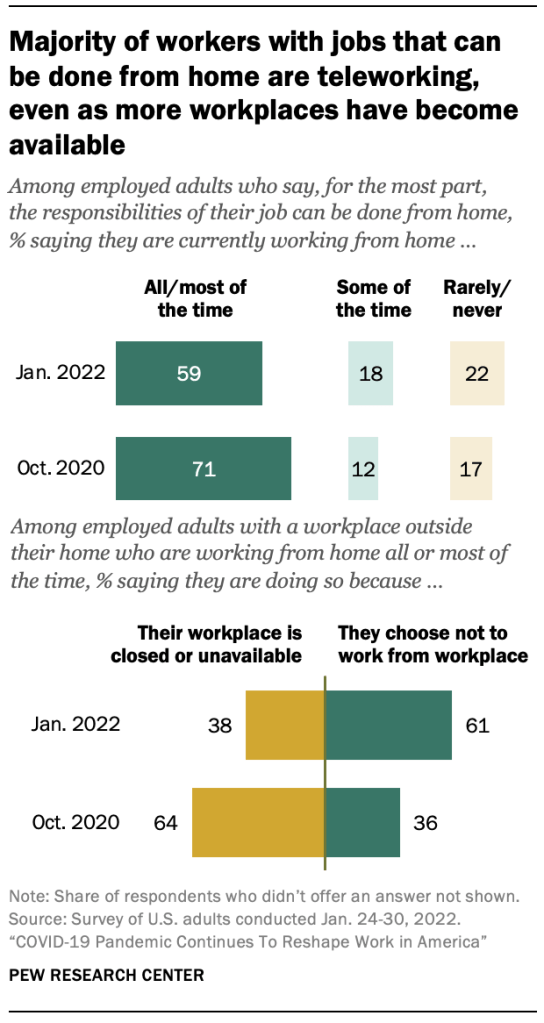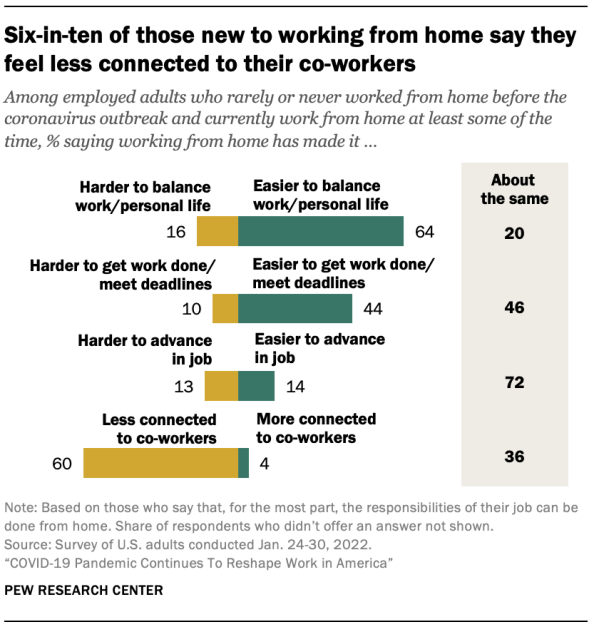There is an ever-growing need for collaboration tools, thanks to the millions of workers who now find themselves working from home, or at least remotely. And according to a Pew Research Center study, roughly six-in-ten U.S. workers say: they can do their job from home. That amounts to 59% who work from home all or most of the time, the Pew Research Center found.
Although the Pew Research Center notes that 60 percent of Americans say; they can do their job from home: there remains a sizable amount of workers who cannot, according to the report. Sixty percent of workers; can't work from home - a gentle reminder that not everybody can and wants to work from home. That could be folks who; work in warehouses, fast-food, grocery stores, and other blue-collar professions.
For employees who benefit from that luxury or the 78% of workers who say "they want to continue working from home after the pandemic," that has its own set of challenges. For those who will benefit from the option to choose how they work, collaboration tools (primarily) fuel those experiences.

I recently sat down with Alfredo Ramirez, President & CEO, of Vyopta, to chat about managing and assuring exceptional user experience across multi-vendor unified communications and collaboration solutions. That includes cloud infrastructure, audio-visual, and traditional user devices group systems, laptops/PCs, smartphones, and desk phones.
Not to exclude some newer applications like XR (extended), AR (augmented), MR (mixed), and VR (virtual reality) devices when working from anywhere. That could be in an office, at a local branch, manufacturing plant, warehouse, or in the field.
Ramirez told me that no matter the workplace situation, handling all this is a complex but crucial undertaking if companies want to support effective collaboration and improve business performance. Also according to him, it is complicated because enterprises lack a single consolidated pane of enterprise-wide visibility and intelligence.
Friction Impacts Speed of Innovation
With employees scattered across the globe, in nearly every role imaginable: managing the kinds of experiences they have can be difficult. And when these employees are in a customer-facing position, ensuring quality experiences is even more vital: according to Ramirez.
He contends that today's collaborative work is nothing like the old manufacturing model, where everyone gets tracked on what it takes to deliver the final product. To him, things are much more geared toward the creative side of work where collaborative work has; what he calls:
"The largest ability to move the needle from a business performance standpoint," adding: "People have always had to work together, from the pyramids to rolling out a vaccine out; to full scale."
If the environment is not conducive to supporting effective collaboration, organizations can't innovate, sell, or help customers properly; Ramirez shared. "Organizations need access to three dimensions of insights, users have to be able to manage and optimize their experience around technology," he added. Here is where IT comes into play, as they must understand how to best optimize that work experience and the facilities; if employees must go into an office.
Friction doesn't enable good experiences, Rameriz told me. What does? Improving the collaborative experience drives better engagement, rather than folks retracting back or growing frustrated. And employees are willing to leave their jobs if they have 'subpar' experiences, as are customers who are more than glad to move to a competitor.
Most people are willing to do so in a heartbeat if they do not get the kind of service they expect. Rameriz further told me that while people need to meet every once in a while, individual work remains impactful. "Lots of folks had artificial confidence they got things done when they were in the office, but remote work forced them to become more goal and process drive - more so than previously," he said.

All this can impact the speed of business innovation, Rameriz noted, adding: "Managers only typically see the result in most cases, so they find it difficult to quantify where the friction or obstacles come in along the way, lots of time." Finding the root cause helps improve overall results, rather than demanding everyone needs to be in the office because of a need to micromanage - he contends.
Not only Office Workers Use Collab Tools
There are tons of employees working in manufacturing and warehouses, the kinds of jobs that also count on collaboration tools: and even some advanced applications like virtual and augmented reality that can help produce microchips from afar.
There are even applications of AR that help pull off remote surgeries assisted by machinery helping doctors. And in research/design and software design, where the goal is not the same all the time - especially if the goal is to produce something well understood - collaboration tools can be; useful.
See how virtual reality helps train employees
This is especially true as most of the time: these companies set aggressive goals. "Some old-school tech product firms want folks in-office, but what about that quiet time?"
Not everyone is (always) collaborating, all the time, or even getting together as much as one might assume. "This is why it remains important to identify if collaborative work happens 20 percent of the time or 40 percent of the time, upfront or at the debrief point - so employees can do their jobs more effectively."
"Really good" managers get this, whereas others will mandate employees come into the office all the time: but there is value in understanding where employees thrive best, which typically yields the best results."
As we continue to push the boundaries of what is possible with the help of collaboration tools, companies and employees will have to continue to adapt. This is especially true as customer expectations, too, continue to rise. With so many tools helping facilitate various experiences, it remains important for intelligence to stay at the center of tweaking said experiences.
If these tools are leveraged right, it could mean the difference between retaining a customer and losing one because of an experience that could have been better.
Ramirez believes that now is the time to make the investment in intelligence tools, not just because that's what Vyopta does, but because, as he said, he's seen the technology make a difference in things like a company's bottom line along with customer and employee happiness/productivity.



